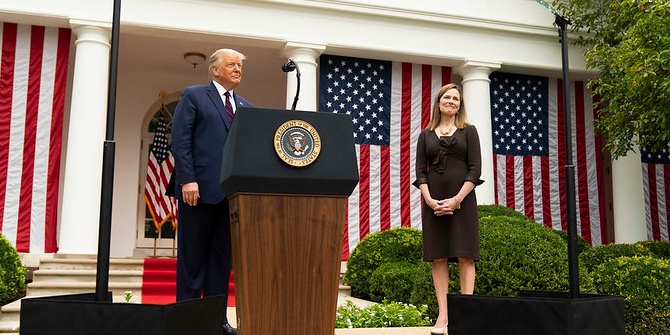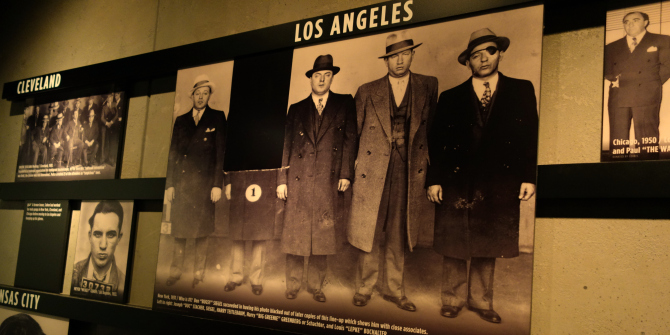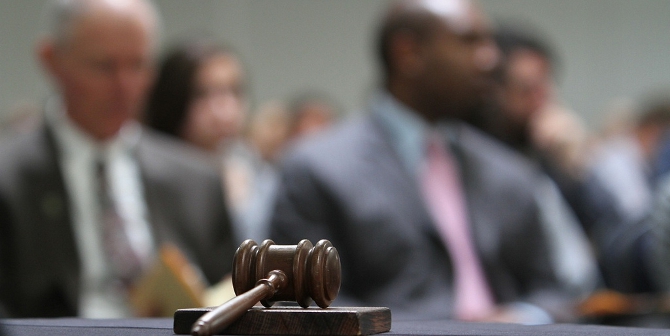 This week Wisconsin will hold a non-partisan primary election for a seat on the state’s Supreme Court. Wendy Scattergood writes that the election, which will help to determine whether the court has a majority of liberals or conservatives, is being influenced by national and local political polarization, and is on track to break electoral spending records, with large amounts of funding coming from outside groups. Whoever wins, she writes, the result will have significant impacts on issues in Wisconsin like abortion and voting rights.
This week Wisconsin will hold a non-partisan primary election for a seat on the state’s Supreme Court. Wendy Scattergood writes that the election, which will help to determine whether the court has a majority of liberals or conservatives, is being influenced by national and local political polarization, and is on track to break electoral spending records, with large amounts of funding coming from outside groups. Whoever wins, she writes, the result will have significant impacts on issues in Wisconsin like abortion and voting rights.
Wisconsin is one of 38 states who elect their high court judges. On Tuesday, February 21st, Wisconsin will hold a non-partisan election for the Wisconsin State Supreme Court. The two candidates who garner the most votes in the primary will then face off in the April 4th general election. Since the early 2000s, court races across the country have become more hotly contested, expensive and polarized. While the court is officially non-partisan, with a current balance of 4-3 in favor of conservatives, at stake in Wisconsin is the majority of the Court which will have a significant impact on the cases that come before them like abortion, election laws, as well as economic, environmental, and social policies. Just as with court elections in other states in 2022, Wisconsin’s Supreme Court campaign is being closely monitored by interest groups and political parties all over the country as a test of liberal and conservative constituencies.
Who’s running in this state Supreme Court election?
Justice Patience Roggensack, whose ten-year term is expiring, is not running for re-election. Three sitting judges and a former Wisconsin Supreme Court justice are running to replace her. Jennifer Dorrow is a county judge who gained statewide recognition as the presiding justice over the man convicted of driving his SUV through a Christmas parade, killing several people and injuring dozens. She has endorsements from prominent Republicans in the state and near universal support from conservative talk radio.
Daniel Kelly was appointed as a replacement on the Wisconsin Supreme Court by Republican Governor Scott Walker in 2016, but when that term was up four years later, he lost his re-election bid to liberal justice Jill Karofsky. He has been an outspoken critic of abortion, same-sex marriage, public employee collective bargaining, and gun control.
There are two liberals running in the primary as well. Janet Protaseiwicz is a county judge and former prosecutor. She has been frank about her progressive beliefs and has endorsements from prominent Democrats in the state, Emily’s List, and many national pro-choice and women’s groups. Everett Mitchell is also a county judge who hears cases from the juvenile division and is a former prosecutor. Mitchell is much less known in the state and has not garnered as much money or attention as Protaseiwicz.
How political polarization has made court elections more like national ones
There are a number of reasons why this election may prove to be significantly different from past judicial high court elections in Wisconsin. Traditionally, these elections were low key, with candidates often getting bipartisan endorsements and largely funding their own campaigns. However, as political polarization ramped up both nationally and in Wisconsin, high court elections also became more contentious and more expensive. The current election is on track to break even those records. Not only are candidates fundraising from donors within the state, but outside groups are funding candidate campaigns as well as running independent ads. Protaseiwicz has far out-raised the other candidates. Estimates are that she has raised over $1.6 million compared to Dorrow with over $672,000, Kelly with just over $412,000 and Mitchell with significantly less at $210,000.
State Supreme Court election voter turnout typically is quite a bit older and more conservative than gubernatorial or national elections, especially in the primaries for these off-year elections. This trend might predict that both conservative candidates could make it through to the run-off election in April. That most likely will not be the case in this election, however. Following the overturning of Roe v. Wade last year by the US Supreme Court, Wisconsin’s 1849 abortion law, which makes it a felony in most circumstances to perform an abortion, is being contested through the court system. It is widely recognized that the ideological balance of the state Supreme Court will likely decide the legality of Wisconsin’s abortion law. This will drive turnout among younger and more liberal groups.

“Moot court at the Wisconsin Supreme Cour” (CC BY-NC 2.0) by Ann Althouse
In addition, Kelly is taking an unusual strategy of focusing much of his campaign attention attacking his conservative opponent Dorrow, going so far as to imply that he would not endorse her should she make it past the primary if he didn’t. In addition, outside conservative groups are spending hundreds of thousands of dollars attacking Dorrow in support of Kelly. Among the liberal candidates, the race seems much more one-sided in terms of funding and endorsements going toward Protaseiwicz. This may have the effect of dividing the conservative vote compared to a more unified liberal vote, resulting in a face-off between a liberal and a conservative candidate in April.
Prognosticators looking at surprises in the 2022 elections as indicators of trends for 2024 will be watching the few races like Wisconsin’s in 2023. For those folks, this race may not be a great bellwether in that regard. For example, in Wisconsin Supreme Court elections in 2018 and 2019 where there were no other statewide or national elections occurring at the same time, the voters elected one liberal and one conservative (respectively), therefore it would be hard to look at Wisconsin, one of the few actual swing states, for some sort of trend. On the other hand, watching this race is important for those interested in key issues such as abortion and voting rights. The ideological majority of the court to be determined by this election will have significant impacts on those issues in Wisconsin.
An eventful campaign to come?
Once past Tuesday’s primaries, the candidates, the state political parties, as well as outside groups will ramp up their ads heading into the April general election. In a state used to being bombarded with political ads during elections, Wisconsonites can expect the same in this election. In general, voter turnout is driven by interest, ads, what’s at stake, and perception of how close the race is. These factors are all present in abundance in this election. Moving into April, it is expected that the liberals will try to focus the campaign on abortion (the majority of Wisconsin adults tend to favor abortion in most cases), while the conservatives will seek to expand the debate to issues involving cash bail and work requirements for those seeking welfare benefits (advisory referenda on these issues have passed the state legislature and will be on the ballot in April). While turnout is not expected to reach gubernatorial, much less presidential election rates, it should still defy recent numbers. All eyes will once again be on Wisconsin as a prime example of US political polarization, this time within the third branch of government; the one that the framers of the US Constitution famously said should be above the fray of politics.
- Please read our comments policy before commenting.
- Note: This article gives the views of the author, and not the position of USAPP– American Politics and Policy, nor of the London School of Economics.
- Shortened URL for this post: https://bit.ly/41f0eHg






